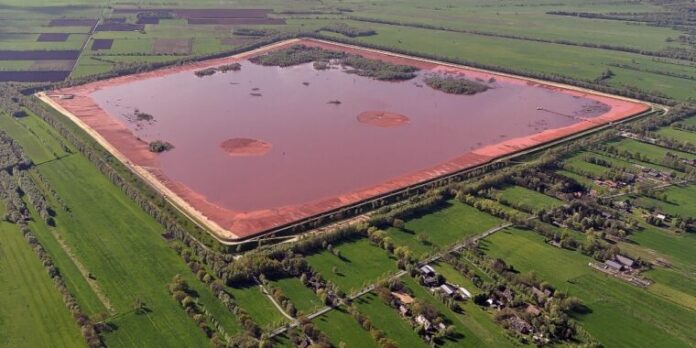The metals that form the foundation of modern society also cause a number of problems. Separating the metals we want from other minerals is often energy-intensive and can leave behind large volumes of toxic waste. Getting them in a pure form can often require a second and considerable energy input, boosting the associated carbon emissions.
A team of researchers from Germany has now figured out how to handle some of these problems for a specific class of mining waste created during aluminum production. Their method relies on hydrogen and electricity, which can both be sourced from renewable power and extracts iron and potentially other metals from the waste. What’s left behind may still be toxic but isn’t as environmentally damaging.
Out of the mud
The first step in aluminum production is the isolation of aluminum oxide from the other materials in the ore. This leaves behind a material known as red mud; it’s estimated that nearly 200 million tonnes are produced annually. While the red color comes from the iron oxides present, there are a lot of other materials in it, some of which can be toxic. And the process of isolating the aluminum oxide leaves the material with a very basic pH.
All of these features mean that the red mud generally can’t (or at least shouldn’t) be returned to the environment. It’s generally kept in containment ponds—globally, these are estimated to house 4 billion tonnes of red mud, and many containment pods have burst over the years.
The iron oxides can account for over half the weight of red mud in some locations, potentially making it a good source of iron. Traditional methods have processed iron ores by reacting them with carbon, leading to the release of carbon dioxide. But there have been efforts made to develop “green steel” production in which this step is replaced by a reaction with hydrogen, leaving water as the primary byproduct. Since hydrogen can be made from water using renewable electricity, this has the potential to eliminate a lot of the carbon emissions associated with iron production.
The team from Germany decided to test a method of green steel production on red mud. They heated some of the material in an electric arc furnace under an atmosphere that was mostly argon (which wouldn’t react with anything) and hydrogen (at 10 percent of the mix).
Pumping (out) iron
The reaction was remarkably quick. Within a few minutes, metallic iron nodules started appearing in the mixture. The iron production was largely complete by about 10 minutes. The iron was remarkably pure, at about 98 percent of the material by weight in the nodules being iron.
Starting with a 15-gram sample of red mud, the process reduced this to 8.8 grams, as lots of the oxygen in the material was liberated in the form of water. (It’s worth noting that this water could be cycled back to hydrogen production, closing the loop on this aspect of the process.) Of that 8.8 grams, about 2.6 (30 percent) was in the form of iron.
The research found that there are also some small bits of relatively pure titanium formed in the mix. So, there’s a chance that this can be used in the production of additional metals, although the process would probably need to be optimized to boost the yield of anything other than iron.
The good news is that there’s much less red mud left to worry about after this. Depending on the source of the original aluminum-containing ore, some of this may include relatively high concentrations of valuable materials, such as rare earth minerals. The downside is that any toxic materials in the original ore are going to be significantly more concentrated.
As a small plus, the process also neutralizes the pH of the remaining residue. So, that’s at least one less thing to worry about.
The downside is that the process is incredibly energy-intensive, both in producing the hydrogen required and running the arc furnace. The cost of that energy makes things economically challenging. That’s partly offset by the lower processing costs—the ore has already been obtained and has a relatively high purity.
But the key feature of this is the extremely low carbon emissions. Right now, there’s no price on those in most countries, which makes the economics of this process far more difficult.
Nature, 2024. DOI: 10.1038/s41586-023-06901-z (About DOIs).


